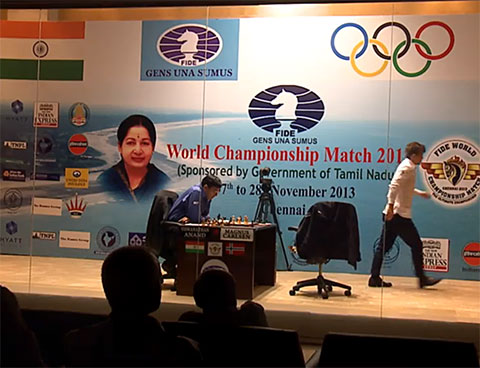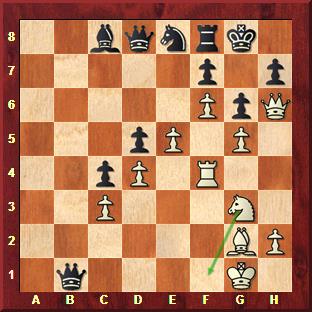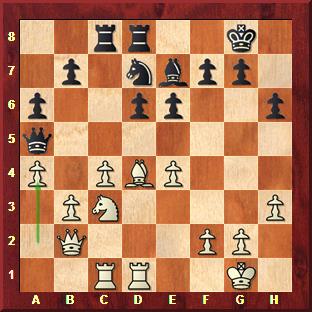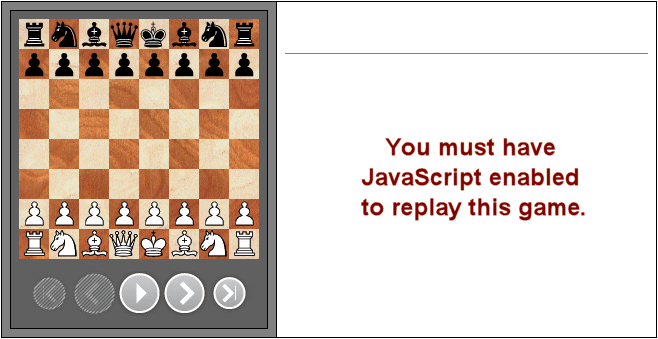


After a promising start that had Indian chess fans shivering in excitement, reigning World Champion Viswanathan Anand came under intense pressure in game five. He missed a draw and dropped the first point in what was probably the crutial game of the match. How did the World Championship 2013 in Chennai continue?
Anand,V (2775) - Carlsen,M (2870) [C65]
FWCM2013 (6), 16.11.2013

Position after 41....Rb7
Anand played 1.e4 which gave him no advantage. He reached the above rook endgame after 41 moves. I think in 9 out of 10 games Anand would draw this endgame with White. But the pressure of playing Magnus was so much that he was unable to hold it. Credit should also go to Carlsen for pressing in the best possible fashion. The match looked effectively over. The most disheartening thing for Anand was that he was being outplayed from positions he would have relatively no problems holding against any other opposition. 4.0-2.0.

The match was played on a stage which was separated from the viewers by a glass wall
Anand,V (2775) - Carlsen,M (2870) [C65]
FWCM2013 (7), 18.11.2013

Final position after 32...Ne6 ½-½
Carlsen,M (2870) - Anand,V (2775) [C67]
FWCM2013 (8), 19.11.2013

Position after 28....Kxe8
The above two positions best describe game seven and eight. Symmetrical structures, one open file and all the pieces getting exchanged periodically. In game six and seven, Anand had the white pieces consecutively. After repeatedly failing to get an advantage with 1.e4 in the match, people expected Anand to go 1.d4 in game seven. But it was not to be. Once again Magnus’s symmetrical King Pawn Opening gave him a very safe and secure position. In game eight, reaching a pawn endgame in just 28 moves was just what the doctor ordered. The challenger had now cemented his lead. 5.0-3.0.

Tremendous media interest for the match Not only was it covered by
the leading Indian periodicals, the match was actually shown live on television.
A video by Vijay Kumar and Susan Polgar takes you behind the scenes of the playing venue.
Huge excitement for fans all over the world as Anand finally opened with 1.d4. It seemed as if he had delayed this obvious switch for too long. But all was not lost. If Vishy could win this, he would reduce the gap by just one point. The game was wild and complicated – it saw Magnus promoting his pawn to a queen and Vishy launching a mad attack on Black’s king. But Anand’s confidence seemed to be on the decline as he could not find a forced win. Carlsen defended accurately and there occurred the biggest blunder of the match.
Anand,V (2775) - Carlsen,M (2870) [E25]
FWCM2013 (9), 21.11.2013

Position after 28.Nf1
In the above positon, Anand played the fateful 28.Nf1?? and after 28…Qe1 had to throw in the towel. It was all over. 6.0-3.0.

Better late than never: 1.d4 by Vishy Anand

Magnus Carlsen mobbed by the media as he inched closer to the title
Carlsen,M (2870) - Anand,V (2775) [B51]
FWCM2013 (10), 22.11.2013

Position after 22.a4
The thing that stands out for me in the match is this position. Carlsen had a chance to repeat the position with 22.Qd2 and make a draw. With that he would win the match and be the undisputed World Champion. But he declined the tacit draw offer and instead continued playing. Such hunger for victory is the reason why Magnus is way ahead of others. He was close to winning the tenth game too. After a mistake he had to agree for a draw. But it was only after 65 moves of fighting chess! 6.5-3.5.

Magnus Carlsen: Sixteenth World Chess Champion

Guess what the newly crowned World Champion did after winning the match? Basketball!
Conclusion: In the first half of the match, Anand had his chances. Magnus was jittery and was not his usual flawless self. But Vishy didn’t grab them. That gave Carlsen time to settle down. Once he started to feel at home in the World Championship environment, he simply dominated the match. Anand sticking to 1.e4 for too long led to his doom. And lastly Magnus was able to steer the game into the positions he liked more often than Anand could do it. That’s the reason why Vishy could not win a single game in the match.
Trivia: Who are the players in the history of world championship matches who have not been able to win a single game in a match? The answer is given at the end of the article.

Select games from the dropdown menu above the board